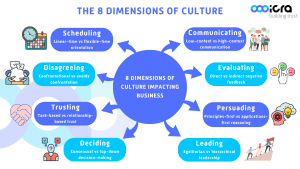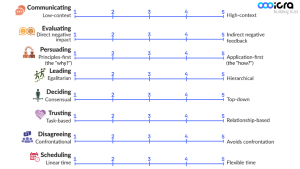The Culture Map is a framework developed by Erin Meyer to help individuals and organizations navigate cultural differences in the workplace, across eight key cultural dimensions. It provides insights into how people from different cultural backgrounds communicate, make decisions, build trust, give feedback, and approach leadership and collaboration. While the Culture Map was initially developed to explore differences between national cultures, its principles can be effectively applied to the culture of organizations themselves. Organizations, like countries, develop their own unique cultures. Exploring these dimensions helps you decode your organization’s internal dynamics and build stronger, more effective partnerships!
Let’s first explain those eight dimensions of culture:
- Communicating: Is communication low-context (direct and explicit) or high-context (nuanced and reliant on shared understanding)?
- Evaluating: Is feedback given directly and bluntly, or diplomatically to preserve harmony?
- Persuading: Does your team emphasize principles-first reasoning (start with a theory to address the problem and then creating a solution, the “why”) or applications-first reasoning (start with the solution, the “how”)?
- Leading: Are leadership styles egalitarian (flat hierarchy) or hierarchical (clear authority)?
- Deciding: Is decision-making consensus-driven (involves a high number of participants) or top-down (the decision comes from authority)?
- Trusting: Is trust built through performance (task-based) or personal relationships (relationship-based)?
- Disagreeing: Is disagreement seen as a path to creativity or considered a disruption of the group’s harmony?
- Scheduling: Is time managed linearly (starting the next task is coming after finishing the previous one) or flexibly (adaptable to circumstances)?

8 cultural dimensions – Based on Meyer, E. (2016). The culture map. PublicAffairs.
Why It Matters
The Culture Map is essential for enhancing alignment and collaboration within and outside your organization. By clarifying your cultural tendencies together, you create a shared understanding that reduces internal friction and fosters cohesion. Externally, the framework allows you to identify synergies with partners and anticipate challenges rooted in cultural differences. It also empowers organizations to drive innovation and efficiency by aligning people and processes with a clear cultural vision. Regularly revisiting the map ensures your organizational culture evolves alongside your mission and values, helping you future-proof your strategies and build stronger, more resilient partnerships!
Your Next Step
Turn this into a team activity! Ask each employee to map where they think your organization stands on these eight dimensions. Once you’ve gathered the responses, compare the results. If there’s consistency, celebrate your shared understanding. If opinions vary widely, it might be time to revisit your strategies to ensure internal alignment.

Cultural mapping tool iCRA – Based on Meyer, E. (2016). The culture map. PublicAffairs.
Pro Tip:
Do this mapping activity not only internally but also with external partners. By mapping out both organizations, you can identify natural synergies and anticipate potential challenges!

